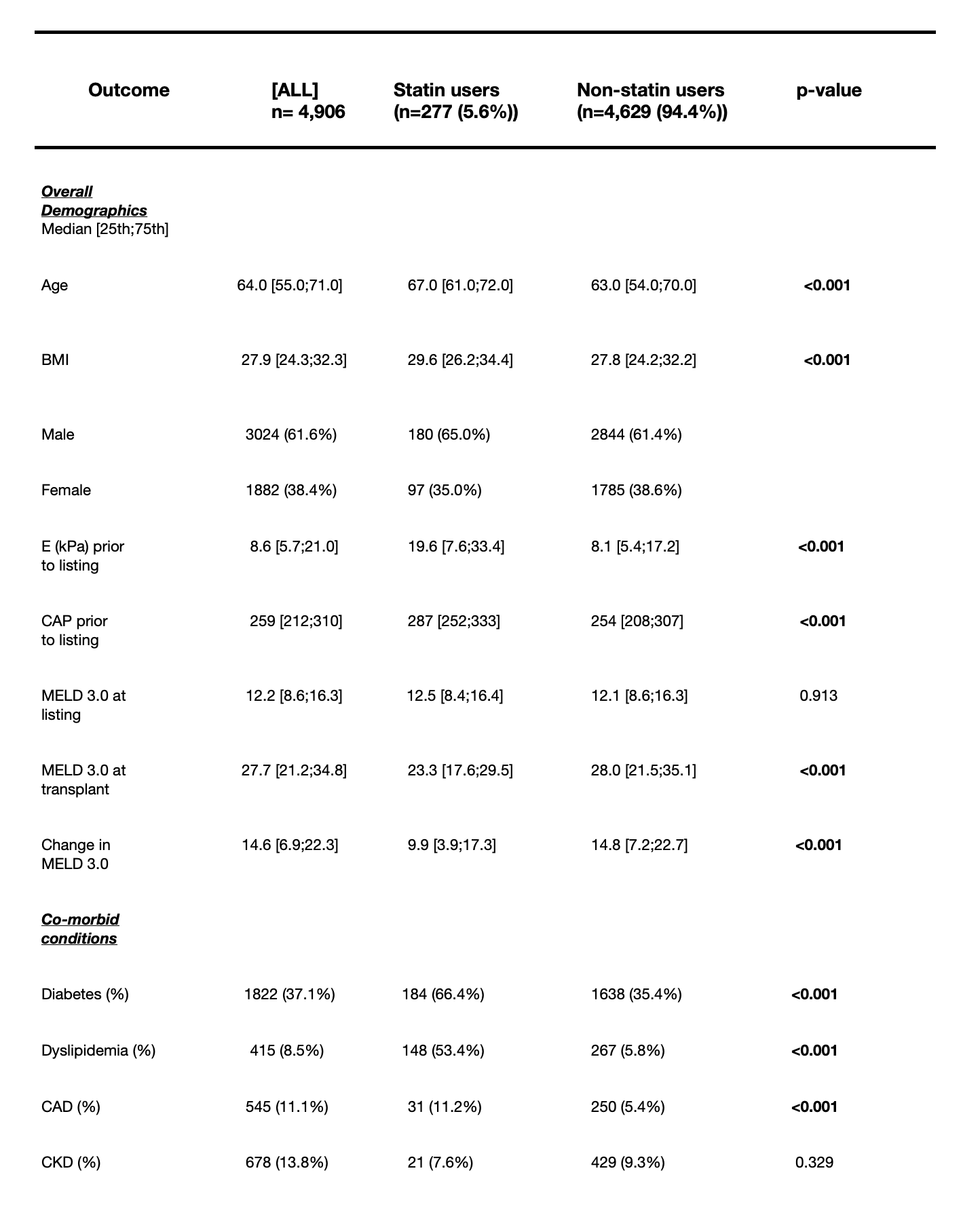Sunday Poster Session
Category: Liver
P1513 - Statin Use Is Associated With Slower MELD Progression in Liver Transplant Candidates
Sunday, October 26, 2025
3:30 PM - 7:00 PM PDT
Location: Exhibit Hall

Rishaan R. Sharma, MD (he/him/his)
Cleveland Clinic Foundation
Cleveland, OH
Presenting Author(s)
Rishaan R. Sharma, MD1, John McMichael, PhD1, Meeta Bhardwaj, DO, MPH1, Victor Castro, MD1, Kalyan Bhamidimarri, MD2, Xaralambos Zervos, DO2, Nicholas Ruthmann, MD1, Omar Sims, PhD3, Shilpa Junna, MD1
1Cleveland Clinic Foundation, Cleveland, OH; 2Cleveland Clinic Florida, Weston, FL; 3Cleveland Clinic Foundation, Hoover, AL
Introduction: Statins have demonstrated potential antifibrotic and anti-inflammatory effects in chronic liver disease, but their clinical impact during the peri transplant period remains uncertain. This study compares liver stiffness, hepatic steatosis, and MELD progression between statin users and non-users among adult liver transplant candidates.
Methods: This multicenter retrospective study included 4,906 adult liver transplant (LT) candidates listed between January 2000 and October 2023 at Cleveland Clinic (Ohio and Florida). Patients were stratified by statin use: statin users (n=277, 5.6%) had active prescriptions for ≥60 days before and after listing, while non-users (n=4,629, 94.4%) served as controls. Patients with acute liver failure or undergoing re-transplantation were excluded. The most recent liver stiffness (E_kpa) and hepatic steatosis (CAP) scores obtained via vibration-controlled transient elastography prior to listing were analyzed. MELD 3.0 scores at listing and transplant were used to calculate MELD progression. Demographic and clinical characteristics were extracted from structured documentation. Continuous variables were compared using the Wilcoxon rank-sum test, and categorical variables using Pearson’s chi-square test; statistical significance was defined as p < 0.05.
Results: A total of 4,906 patients were included (277 statin users, 4,629 non-users). Statin users were older (median age 67 vs. 63 years), had higher BMI (29.6 vs. 27.8 kg/m²), and greater prevalence of diabetes (66.4% vs. 35.4%), CAD (36.8% vs. 9.6%), and CKD (27.4% vs. 13.0%) compared to non-users (all p < 0.001). In addition to more comorbidities, statin users had significantly greater liver stiffness (median E_kpa 19.6 [IQR 7.6–33.4] vs. 8.1 [5.4–17.2], p < 0.001) and CAP (287 vs. 254 dB/m, p < 0.001). MELD scores at listing were similar (12.5 vs. 12.1, p = 0.900), but MELD progression was significantly slower in statin users (median +9.9 [3.9–17.3] vs. +14.8 [7.2–22.7], p < 0.001).
Discussion: In this large multicenter cohort, statin users exhibited more advanced fibrosis and greater comorbidity burden, yet experienced significantly slower MELD progression during the peri transplant period compared to non-users. These findings may suggest a potential protective role of statins in cirrhotic disease progression and supports further investigation of statins as a modifiable factor in liver transplant populations.

Figure: Table 1. Demographic & Outcome Data
Disclosures:
Rishaan Sharma indicated no relevant financial relationships.
John McMichael indicated no relevant financial relationships.
Meeta Bhardwaj indicated no relevant financial relationships.
Victor Castro indicated no relevant financial relationships.
Kalyan Bhamidimarri: Akero – Grant/Research Support. Arbutus – Grant/Research Support. Fractyl – Grant/Research Support. Madrigal – Advisory Committee/Board Member, Speakers Bureau. Mirum – Advisory Committee/Board Member. Orphalan – Advisory Committee/Board Member, Grant/Research Support.
Xaralambos Zervos indicated no relevant financial relationships.
Nicholas Ruthmann indicated no relevant financial relationships.
Omar Sims indicated no relevant financial relationships.
Shilpa Junna indicated no relevant financial relationships.
Rishaan R. Sharma, MD1, John McMichael, PhD1, Meeta Bhardwaj, DO, MPH1, Victor Castro, MD1, Kalyan Bhamidimarri, MD2, Xaralambos Zervos, DO2, Nicholas Ruthmann, MD1, Omar Sims, PhD3, Shilpa Junna, MD1. P1513 - Statin Use Is Associated With Slower MELD Progression in Liver Transplant Candidates, ACG 2025 Annual Scientific Meeting Abstracts. Phoenix, AZ: American College of Gastroenterology.
1Cleveland Clinic Foundation, Cleveland, OH; 2Cleveland Clinic Florida, Weston, FL; 3Cleveland Clinic Foundation, Hoover, AL
Introduction: Statins have demonstrated potential antifibrotic and anti-inflammatory effects in chronic liver disease, but their clinical impact during the peri transplant period remains uncertain. This study compares liver stiffness, hepatic steatosis, and MELD progression between statin users and non-users among adult liver transplant candidates.
Methods: This multicenter retrospective study included 4,906 adult liver transplant (LT) candidates listed between January 2000 and October 2023 at Cleveland Clinic (Ohio and Florida). Patients were stratified by statin use: statin users (n=277, 5.6%) had active prescriptions for ≥60 days before and after listing, while non-users (n=4,629, 94.4%) served as controls. Patients with acute liver failure or undergoing re-transplantation were excluded. The most recent liver stiffness (E_kpa) and hepatic steatosis (CAP) scores obtained via vibration-controlled transient elastography prior to listing were analyzed. MELD 3.0 scores at listing and transplant were used to calculate MELD progression. Demographic and clinical characteristics were extracted from structured documentation. Continuous variables were compared using the Wilcoxon rank-sum test, and categorical variables using Pearson’s chi-square test; statistical significance was defined as p < 0.05.
Results: A total of 4,906 patients were included (277 statin users, 4,629 non-users). Statin users were older (median age 67 vs. 63 years), had higher BMI (29.6 vs. 27.8 kg/m²), and greater prevalence of diabetes (66.4% vs. 35.4%), CAD (36.8% vs. 9.6%), and CKD (27.4% vs. 13.0%) compared to non-users (all p < 0.001). In addition to more comorbidities, statin users had significantly greater liver stiffness (median E_kpa 19.6 [IQR 7.6–33.4] vs. 8.1 [5.4–17.2], p < 0.001) and CAP (287 vs. 254 dB/m, p < 0.001). MELD scores at listing were similar (12.5 vs. 12.1, p = 0.900), but MELD progression was significantly slower in statin users (median +9.9 [3.9–17.3] vs. +14.8 [7.2–22.7], p < 0.001).
Discussion: In this large multicenter cohort, statin users exhibited more advanced fibrosis and greater comorbidity burden, yet experienced significantly slower MELD progression during the peri transplant period compared to non-users. These findings may suggest a potential protective role of statins in cirrhotic disease progression and supports further investigation of statins as a modifiable factor in liver transplant populations.

Figure: Table 1. Demographic & Outcome Data
Disclosures:
Rishaan Sharma indicated no relevant financial relationships.
John McMichael indicated no relevant financial relationships.
Meeta Bhardwaj indicated no relevant financial relationships.
Victor Castro indicated no relevant financial relationships.
Kalyan Bhamidimarri: Akero – Grant/Research Support. Arbutus – Grant/Research Support. Fractyl – Grant/Research Support. Madrigal – Advisory Committee/Board Member, Speakers Bureau. Mirum – Advisory Committee/Board Member. Orphalan – Advisory Committee/Board Member, Grant/Research Support.
Xaralambos Zervos indicated no relevant financial relationships.
Nicholas Ruthmann indicated no relevant financial relationships.
Omar Sims indicated no relevant financial relationships.
Shilpa Junna indicated no relevant financial relationships.
Rishaan R. Sharma, MD1, John McMichael, PhD1, Meeta Bhardwaj, DO, MPH1, Victor Castro, MD1, Kalyan Bhamidimarri, MD2, Xaralambos Zervos, DO2, Nicholas Ruthmann, MD1, Omar Sims, PhD3, Shilpa Junna, MD1. P1513 - Statin Use Is Associated With Slower MELD Progression in Liver Transplant Candidates, ACG 2025 Annual Scientific Meeting Abstracts. Phoenix, AZ: American College of Gastroenterology.
